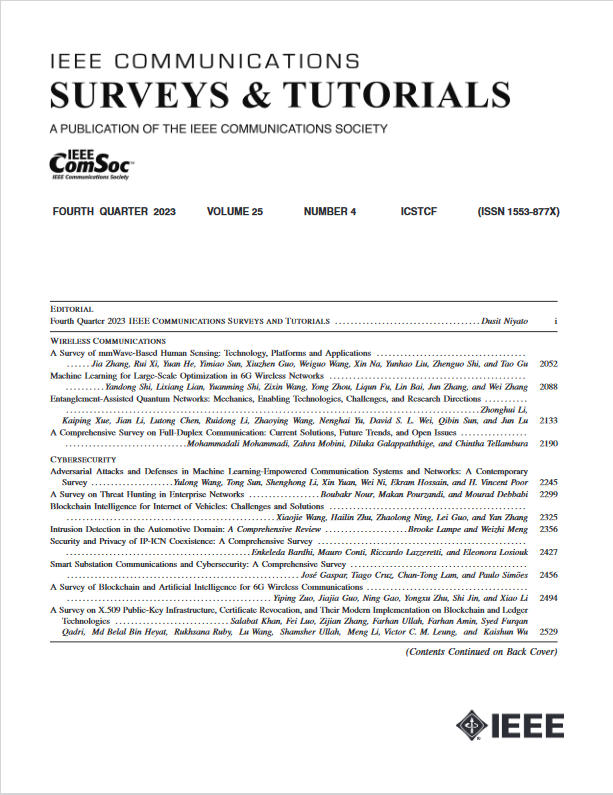在 5G 及更高网络切片背景下改进富媒体内容传输的人工智能技术概览
IF 34.4
1区 计算机科学
Q1 COMPUTER SCIENCE, INFORMATION SYSTEMS
引用次数: 0
摘要
网络切片是一种新兴的范例,其目标是在高度发展和动态的5G及以后的网络环境中为个性化服务提供支持。富媒体内容交付的网络切片架构下的网络功能和资源管理是一项具有挑战性的任务,需要在所有网络级别上进行有效的决策,以保持所需的服务质量(QoS)和体验质量(QoE)。在网络切片体系结构中集成人工智能(AI)以进行有效的网络决策是解决这一问题的潜在方法之一。在本文中,我们总结了网络切片使能技术,如软件定义网络(SDN),网络功能虚拟化(NFV),多访问边缘计算(MEC)在人工智能背景下改善富媒体内容交付。此外,我们还全面调查了基于网络切片技术的以内容为中心的网络和交付解决方案,即支持mpeg - dash的信息中心网络(ICN)和内容交付网络(CDN),用于智能富媒体内容缓存和预取、预测分析、内容偏好优化、安全资源分配和动态流量控制。然后介绍了3GPP提出的5G网络切片的几种标准化和编排机制。最后,概述了人工智能支持的5G网络切片用于沉浸式内容交付的挑战,以及潜在的解决方案和未来的研究机会。本文章由计算机程序翻译,如有差异,请以英文原文为准。
A Survey on Artificial Intelligence Techniques for Improved Rich Media Content Delivery in a 5G and Beyond Network Slicing Context
Network slicing is an emerging paradigm driven by an objective to provide support for personalized services in the highly evolving and dynamic 5G and beyond network environment. The management of network functions and resources under network slicing architecture for rich media content delivery is a challenging task that requires an efficient decision at all network levels to maintain the required Quality of Service (QoS) and Quality of Experience (QoE). Integrating Artificial Intelligence (AI) in the network slice architecture for taking efficient network decision is one of the potential solutions to the problem. In this paper, we summarize the network slicing enabling technologies such as Software Defined Network (SDN), Network Function Virtualization (NFV), Multi-access Edge Computing (MEC) in the context of AI for improving the rich media content delivery. In addition, we present a comprehensive survey on content-centric networking and delivery solutions based on network slicing technologies i.e., MPEG-DASH-enabled Information Centric Networking (ICN) and Content Delivery Network (CDN) for intelligent rich media content caching and prefetching, predictive analysis, content preference optimization, secure resource allocation, and dynamic traffic steering. Several standardization and orchestration mechanisms of 5G network slicing proposed by 3GPP are then presented. Finally, the challenges of AI-enabled 5G network slicing for immersive content delivery are outlined with potential solutions and future research opportunities.
求助全文
通过发布文献求助,成功后即可免费获取论文全文。
去求助
来源期刊

IEEE Communications Surveys and Tutorials
COMPUTER SCIENCE, INFORMATION SYSTEMS-TELECOMMUNICATIONS
CiteScore
80.20
自引率
2.50%
发文量
84
审稿时长
6 months
期刊介绍:
IEEE Communications Surveys & Tutorials is an online journal published by the IEEE Communications Society for tutorials and surveys covering all aspects of the communications field. Telecommunications technology is progressing at a rapid pace, and the IEEE Communications Society is committed to providing researchers and other professionals the information and tools to stay abreast. IEEE Communications Surveys and Tutorials focuses on integrating and adding understanding to the existing literature on communications, putting results in context. Whether searching for in-depth information about a familiar area or an introduction into a new area, IEEE Communications Surveys & Tutorials aims to be the premier source of peer-reviewed, comprehensive tutorials and surveys, and pointers to further sources. IEEE Communications Surveys & Tutorials publishes only articles exclusively written for IEEE Communications Surveys & Tutorials and go through a rigorous review process before their publication in the quarterly issues.
A tutorial article in the IEEE Communications Surveys & Tutorials should be designed to help the reader to become familiar with and learn something specific about a chosen topic. In contrast, the term survey, as applied here, is defined to mean a survey of the literature. A survey article in IEEE Communications Surveys & Tutorials should provide a comprehensive review of developments in a selected area, covering its development from its inception to its current state and beyond, and illustrating its development through liberal citations from the literature. Both tutorials and surveys should be tutorial in nature and should be written in a style comprehensible to readers outside the specialty of the article.
 求助内容:
求助内容: 应助结果提醒方式:
应助结果提醒方式:


